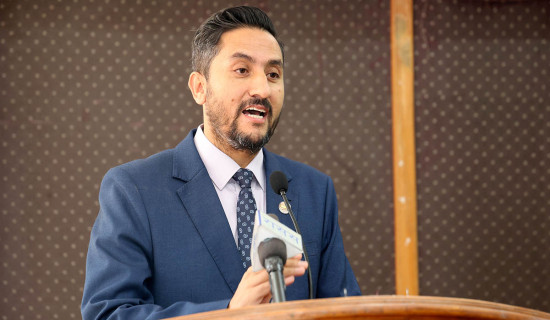- Wednesday, 17 December 2025
Improve Air Safety To Remove EU Ban
Nepal’s aviation and tourism sectors will continue reeling from problems as the European Union (EU) has not lifted Nepali airlines from its decade-long blacklisting. The Department for Mobility and Transport of the EU disclosed this information recently by making public its updated Air Safety List. The list is based on the undivided opinion of member states’ aviation safety experts. They met in Brussels on November 14-16 under the patronage of the EU Air Safety Committee. The EU report mentions that the prohibition has been given continuity because the Nepali airlines, including the national flag carrier, Nepal Airlines Corporation (NAC), have failed to be in compliance with international safety standards.
The document states that the update also reflects the decision to maintain the ban on air carriers certified in Nepal, in view of continued safety concerns identified during an assessment visit to Nepal on 11-15 September, 2023. After the on-site audit carried out by the EU's technical team, high-level government officials were hopeful that the Nepali airlines would be removed from the list of safety concerns.
Reforms
The situation has remained unchanged because of a lack of adequate policy-level and structural reforms. Despite this, the EU’s report says that the Civil Aviation Authority of Nepal (CAAN)’s proactive engagement and ongoing efforts to enhance its safety oversight capacity were duly acknowledged during the EU Air Safety Committee meeting. Frequent air accidents in Nepal have raised questions over the country’s initiatives geared towards air safety. Based on air safety reports of the International Civil Aviation Organisation (ICAO), the EU has stopped Nepali airlines from flying into the European skies since December 2013. The ICAO documents had portrayed Nepal’s aviation safety much lower than a global average. However, the ICAO removed Nepal from the former’s list of Serious Security Concern (SSC) in July 2017.
It is worthwhile to highlight the fact that the EU has continued to request Nepal to split the CAAN into two entities — service provider and regulator. Efforts have also been made in this connection. Two aviation-related bills — the Civil Aviation Authority of Nepal Bill and the Air Service Authority of Nepal Bill — were drafted some years ago to split the civil aviation body. But no concrete progress has so far been made on this front due to apathy on the part of the government and the CAAN leadership. The bills have remained pending. The airlines concerned are also responsible for this situation as they have not paid much-needed attention towards ensuring air safety.
The continuous blacklisting of Nepali airlines has caused huge damage to Nepal. This has not only tainted the nation’s international image but also has prevented the nation from bringing in more tourists from Europe. There is no doubt that Europe is an important traditional tourist source market for Nepal. When NAC and other Nepali carriers are allowed to operate regular and chartered flights to varied European cities, they may bring in more tourists. Currently, Turkish Airlines is the only carrier connecting Istanbul in Europe to Kathmandu.
Despite this obstacle and a sort of global recession, Nepal’s tourism industry has continued to bounce back, creating a lot of confidence among tourism entrepreneurs and other stakeholders. The country has witnessed a considerable rise in the number of foreign travellers in the first 11 months of 2023. According to the Nepal Tourism Board (NTB), the country has received a total of 918,308 tourists during that period. In November, as many as 108,630 tourists made their way into the country while the number stood at 117,306 in the previous month. With a strong recovery of the tourism business, tourist spots located in different parts of the nation have still remained packed with tourists.
Undoubtedly, tourism is a multidimensional sector that creates jobs and other sources of livelihood, boosts the local economy and helps reduce poverty and inequality. It also generates foreign exchanges and contributes to the development of local infrastructure. In addition, tourism directly or indirectly plays a crucial role in conserving the natural environment and cultural heritages as tourists want to visit scenic and pollution-free places with unique culture and tradition. Many tourists visiting Nepal are found interested in exploring rural areas in order to experience the wilderness and culture. Being home to numerous mountains, including Sagarmatha, and world-famous trekking regions such as Annapurna and Khumbu, the country has a lot of attractions to offer to tourists.
Setback
It needs no mention that this sector had suffered a great setback following the outbreak of COVID-19. The nation had to cancel the ambitious national tourism campaign -- Visit Nepal Year-2020 — after many countries across the world were forced to adopt restrictive measures in order to contain the fatal viral disease. With that year-round tourism event, Nepal had targeted to host two million foreign tourists by 2020 and beyond. Inspired by a remarkable increase in tourist arrivals in 2018 and 2019, tourism entrepreneurs had invested more in the hospitality sector. The country was also able to attract many reputed international hotel chains as well. But unfortunately, the country was able to welcome just 230,085 travellers in 2020. The year 2021 remained worst when it comes to tourist arrivals, with just 150,962 tourists. The scenario, however, has kept on improving with a gradual receding of the global public health crisis in 2022. The country recorded more than 600,000 international tourists last year.
Nepal is likely to lure more tourists in the coming years as the country has been in the spotlight globally after UN Secretary-General Antinio Guterres’ recent official visit. The global body’s chief travelled to the country’s top five tourist destinations — Kathmandu, Lumbini, Pokhara, Annapurna Base Camp and Everest Base Camp. Though he focused on climate change issues, his visit is anticipated to help boost the country’s tourism industry. The government must make extra efforts to deal with various problems hindering the tourism sector, including the blacklisting of Nepali airlines.
(The author is a freelancer.)
















